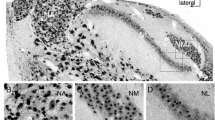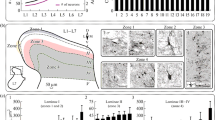Summary
Immunohistochemical investigations with calretinin, a neuronal calcium binding protein, were made in the vestibular end organs of five guinea pigs and one chinchilla. A specific pattern of immunoreactivity of afferent nerve fibers was found. Immunostaining was restricted to thick fibers innervating the apex of the cristae or the striola of the utricular macula. A study of serial sections revealed that the stained afferents gave rise to calyx endings, but not to collaterals containing bouton endings. The results are consistent with the conclusion that, of the three classes of fibers defined by Fernendez et al. (1988, 1990), only calyx units are calretinin immunoreactive. A count of the number of labelled fibers in the chinchilla crista suggests that the entire population of calyx units is immunoreactive. The conclusion is surprising since the physiology of calyx units does not differ qualitatively from that of other afferents (Baird et al. 1988; Goldberg et al. 1990). The presence of this protein in the calyx neurons may be related to specific postsynaptic functions of this type of afferents.
Similar content being viewed by others
Reference
Baird RA, Desmadryl G, Fernández C, Goldberg JM (1988) The vestibular nerve of the Chinchilla. II. Relation between afferent response properties and peripheral innervation patterns in the semicircular canals. J Neurophysiol 60:182–203
Dechesne CJ, Thomasset M, Brehier A, Sans A (1988) Calbindin (CaBP 28 kDa) localization in the peripheral vestibular system of various vertebrates. Hearing Res 33:273–278
Dechesne CJ, Winsky L, Kim HN, Goping G, Vu TD, Wenthold RJ, Jacobowitz DM (1991) Identification and ultrastructural localization of a calretinin-like calcium binding protein (protein 10) in the guinea pig and rat inner ear. Brain Res 560:139–148
Demêmes D, Moniot B, Lomri N, Thomasset M, Sans A (1991) Detection of calbindin-D28k mRNA in rat vestibular ganglion neurons by in situ hybridization. Mol Brain Res 9:153–156
Fernández C, Baird RA, Goldberg JM (1988) The vestibular nerve of the Chinchilla. I. Peripheral innervation patterns in the horizontal and superior semicircular canals. J Neurophysiol 60:176–181
Fernández C, Goldberg JM, Baird RA (1990) The vestibular nerve of the Chinchilla. III. Peripheral innervation patterns in the utricular macula. J Neurophysiol 63:767–780
Goldberg JM, Desmadryl G, Baird RA, Fernández C (1990) The vestibular nerve of the Chinchilla. V. Relation between afferent discharge properties and peripheral innervation patterns in the utricular macula. J Neurophysiol 63:791–804
Maler L, Jande S, Lawson EM (1983) Localization of vitamin D-dependent calcium binding protein in electrosensory and electromotor system of high frequency gymnotid fish. Brain Res 301:166–170
Mattson MP, Rychlik B, Chu C, Christakos S (1991) Evidence for calcium-reducting and excito-protective roles for the calciumbinding protein calbindin-D28k in cultured hippocampal neurons. Neuron 6:41–51
Raymond J, Demêmes D, Nieoullon A (1984) Neurotransmitters in vestibular patways. In: Pompeiano O, Allum JHJ (eds) Vestibulospinal control of posture and locomotion. Progress in brain research, Vol 76. Elsevier, Amsterdam, pp 29–43
Rogers JH (1989a) Two calcium-binding proteins mark many chick sensory neurons. Neurosci 31:697–709
Rogers JH (1989b) Calcium-binding proteins, the search for functions. Nature 339:661–662
Sans A, Brehier A, Moniot B, Thomasset M (1987) Immuno-electronmicroscopic localization of ‘vitamin D-dependent’ calciumbinding protein (CaBP-28k) in the vestibular hair cells of the cat. Brain Res 435:293–304
Takahashi TT, Carr CE, Brecha N, Konishi M (1987) Calcium binding protein-like immunoreactivity labels the terminal field of nucleus laminaris in the barn owl. J Neurosci 7:1843–1856
Winsky L, Nakata H, Martin BM, Jacobowitz DM (1989) Isolation, partial amino acid sequence and immunohistochemical localization of a brain-specific calcium binding protein. Proc Natl Acad Sci USA 86:10139–10143
Author information
Authors and Affiliations
Rights and permissions
About this article
Cite this article
Desmadryl, G., Dechesne, C.J. Calretinin immunoreactivity in chinchilla and guinea pig vestibular end organs characterizes the calyx unit subpopulation. Exp Brain Res 89, 105–108 (1992). https://doi.org/10.1007/BF00229006
Received:
Accepted:
Issue Date:
DOI: https://doi.org/10.1007/BF00229006




